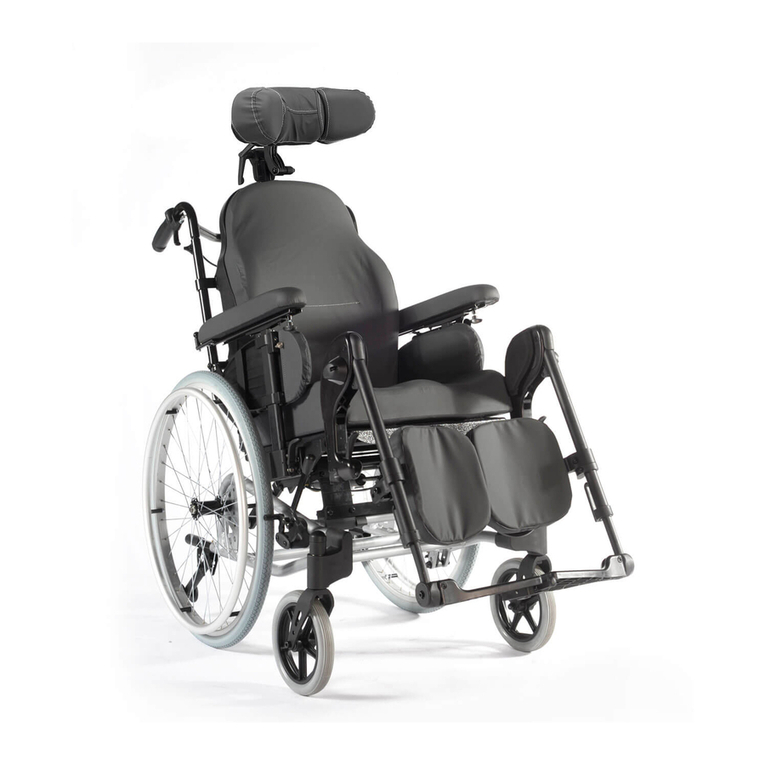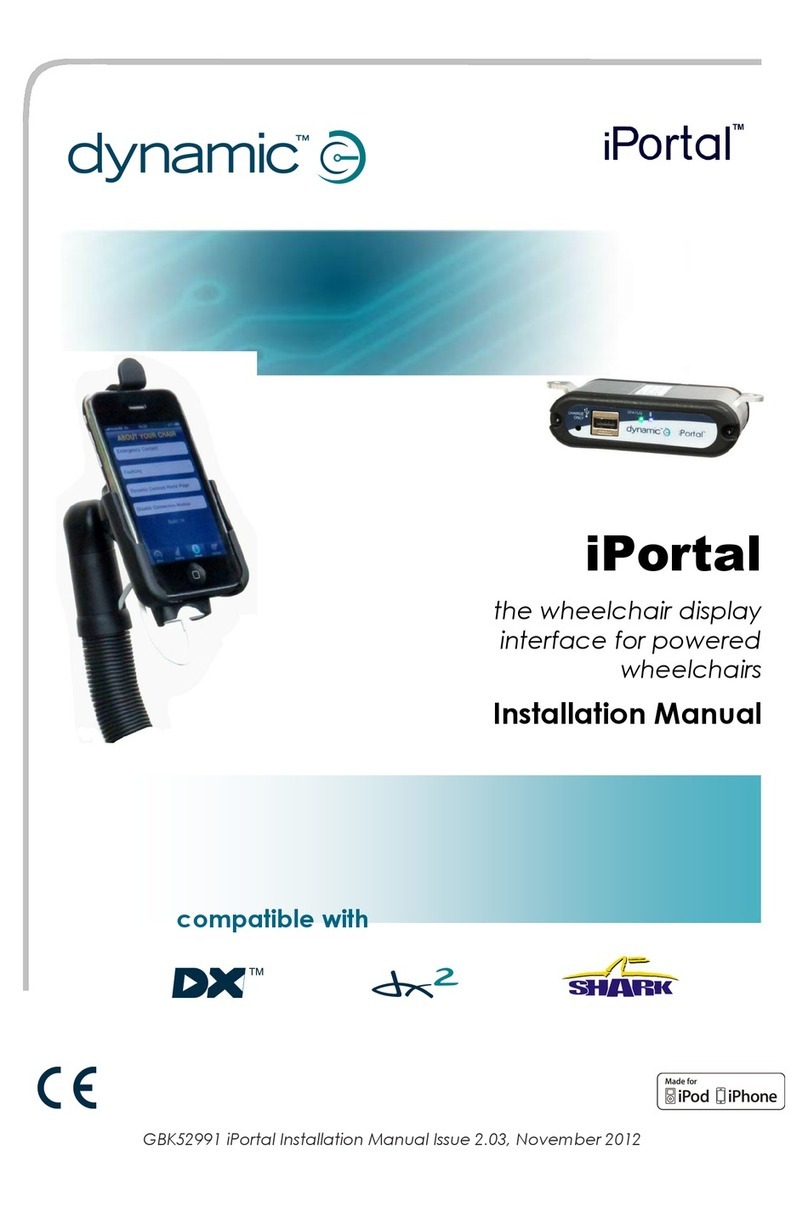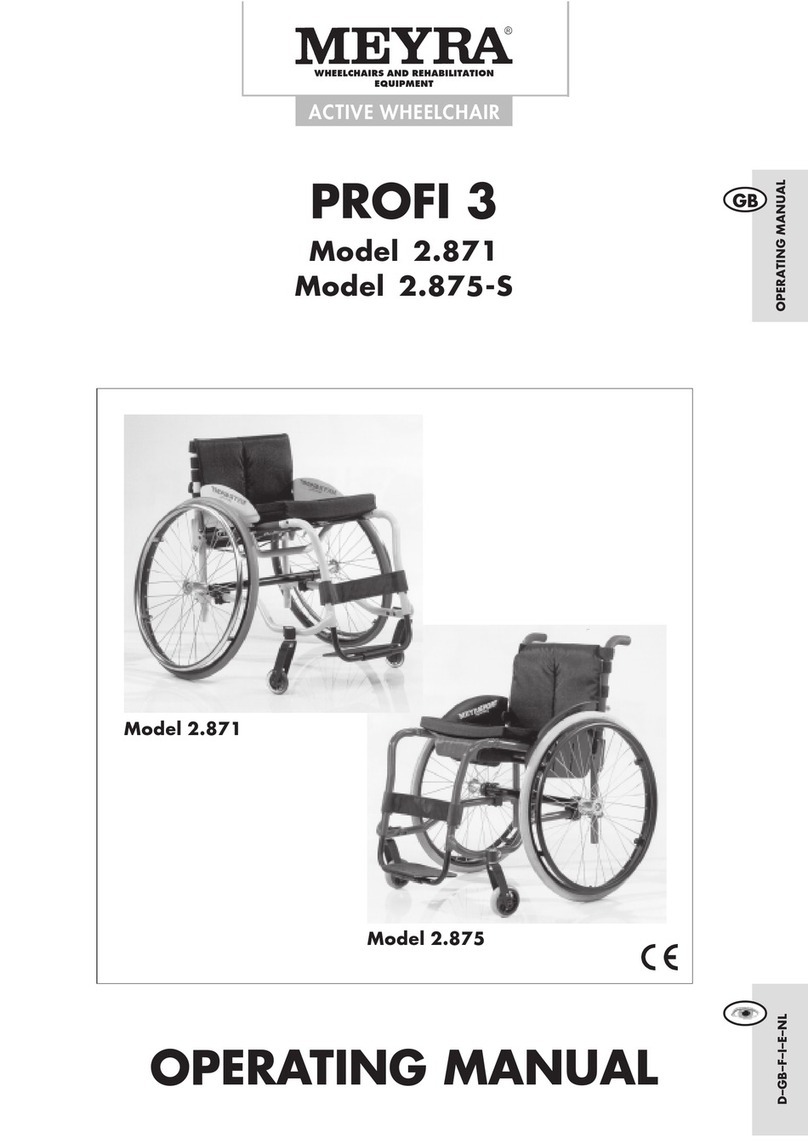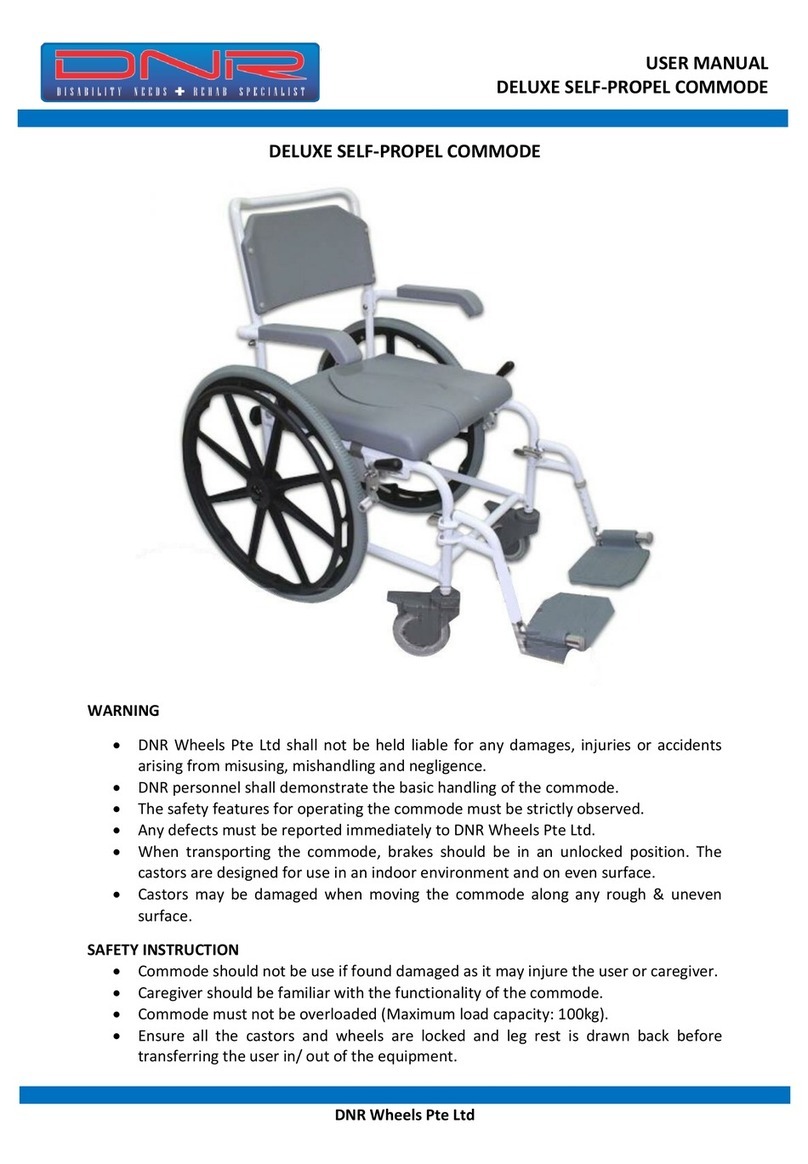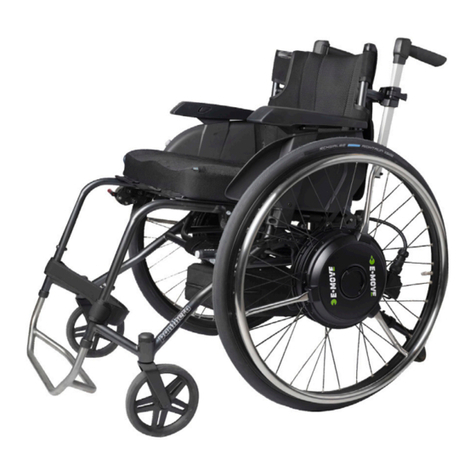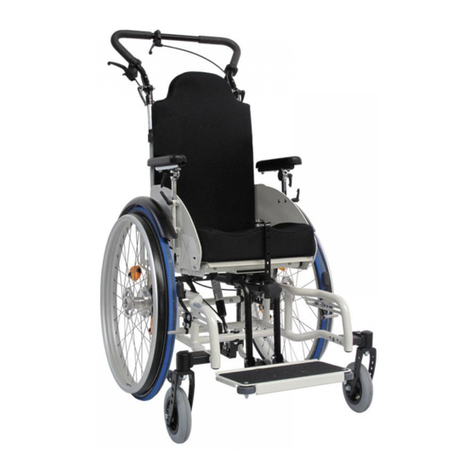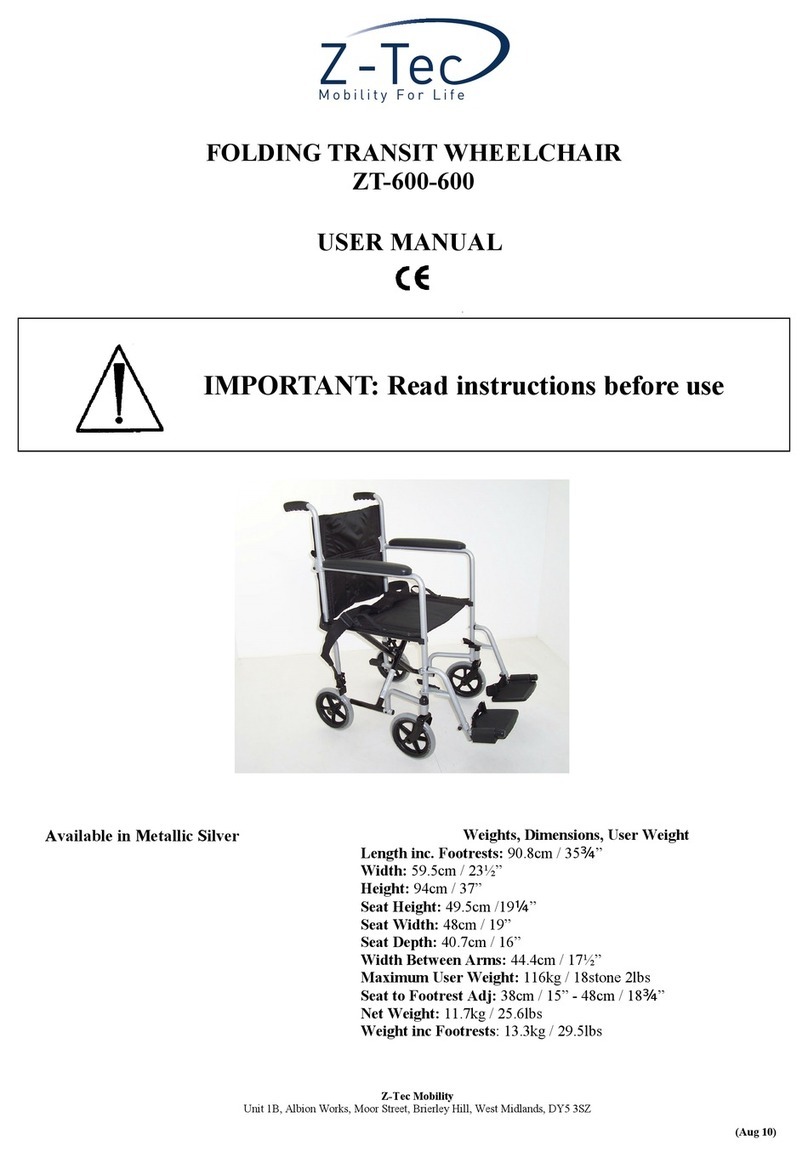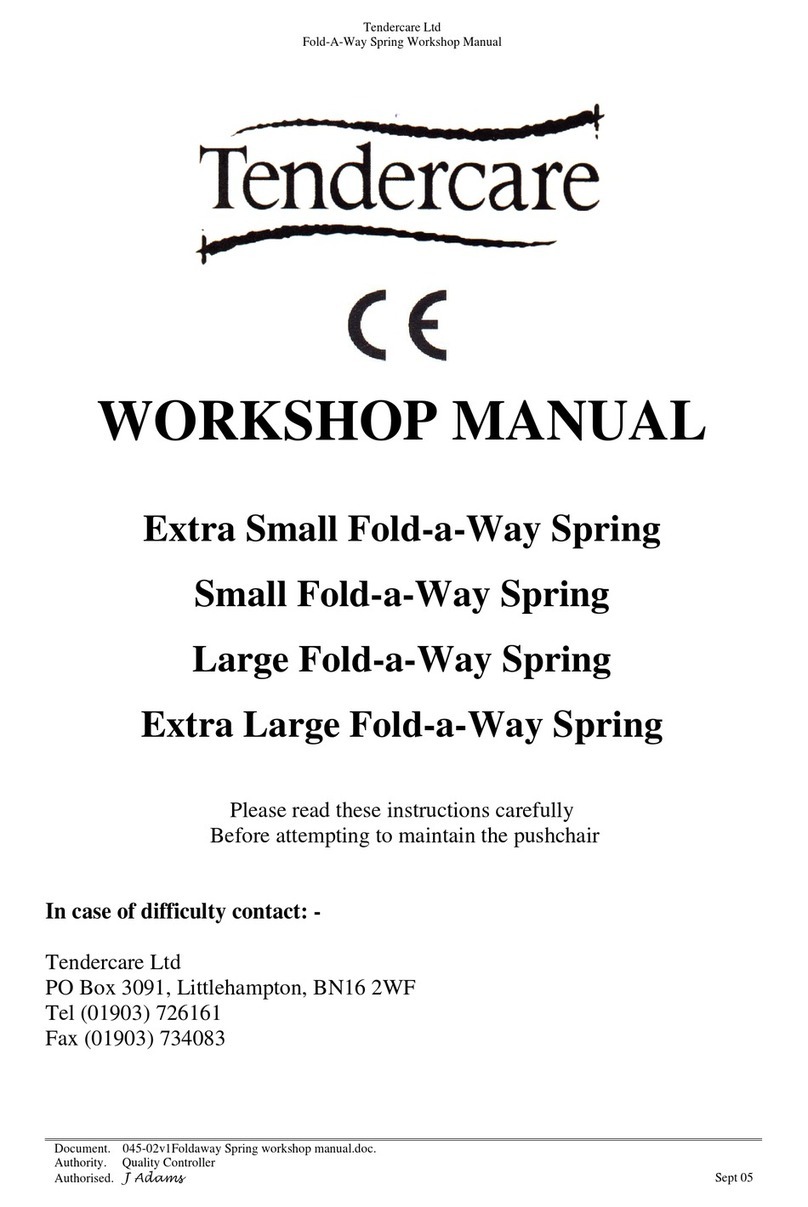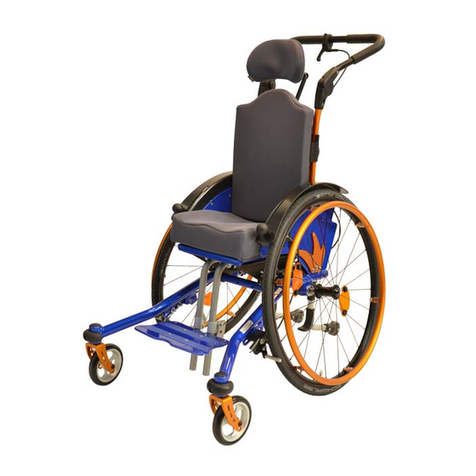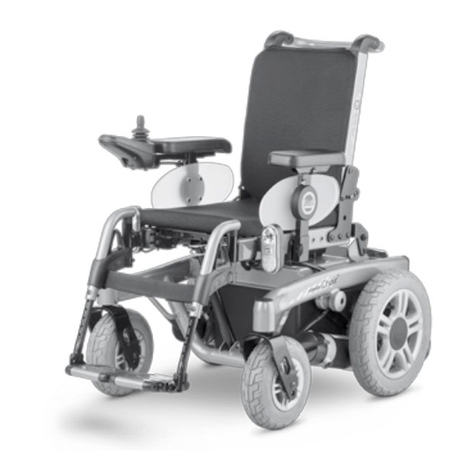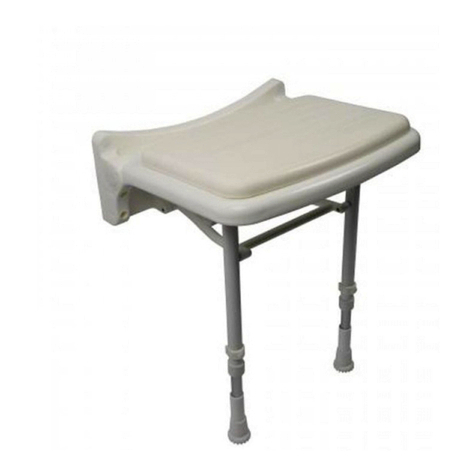Breezy PariX2 Manual

DIRECTIONS FOR USE
GEBRAUCHSANWEISUNG
PariX
WHEELCHAIR
ROLLSTUHL
2
000690914

2
PariX2Rev.2.0
Rollstuhlkomponenten
SUNRISE MEDICAL ist nach ISO 9001 zertiziert und garantiert damit die Qualität unserer Produkte bei allen Entwicklungs- und
Produktionsstufen dieses Rollstuhls. Dieses Produkt erfüllt die Anforderungen gemäß der EU-Richtlinien. Hier abgebildete Optionen oder
Zubehörteile sind gegen Aufpreis erhältlich.
DE
Wheelchair Components
We at SUNRISE MEDICAL have been awarded the ISO-9001 certicate, which afrms the quality of our products at every stage, from R&D to
production. This products meet the requirements in accordance with EC guidelines. Options or accessories shown are available at extra cost.
EN
IF YOU ARE VISUALLY IMPAIRED, THIS DOCUMENT CAN BE VIEWED IN PDF
FORMAT AT WWW.SUNRISEMEDICAL.CO.UK.
FÜR SEHBEHINDERTE PERSONEN STEHT DIESES DOKUMENT IM PDF
FORMAT AUF WWW.SUNRISEMEDICAL.DE

3
PariX2
ENGLISH
Rev.2.0
7
10 9
11
2
1
3
4
5
6
8
12
Wheelchair:
1. Push handles
2. Backrest upholstery
3. Sideguard
4. Seat sling
5. Footrest
6. Castors
7. Foot plate
8. Castor Fork
9. Folding Frame
10. Wheel locks
11. Rear Wheel
12. Arm Pad
6
Rollstuhl:
1. Schiebegriffe
2. Rückenbespannung
3. Seitenteil
4. Sitzbespannung
5. Fußraste
6. Lenkräder
7. Fußbrett
8. Lenkradgabel
9. Faltrahmen
10. Feststellbremsen
11. Antriebsrad
12. Armauflage
20

4
PariX2Rev.2.0
43.5
510mm 8” 3 24” 4 0°
510mm 8” 3 24” 3 3°
485mm 8” 2 24” 3 0°
485mm 8” 2 24” 2 3°
460mm 8” 1 24” 2 0°
460mm 8” 1 24” 1 3°
435mm 6” 1 22” 1 0°
435mm 6” 1 22” 1 3°
1
2
3
1
2
3
4
45 Nm
10 Nm
30 Nm
7 Nm
7 Nm
7 Nm
7 Nm 7 Nm 7 Nm
10 Nm
Nm
M6 = 7.0 Nm

5
PariX2
Rev.2.0
1060
1010
740
580
1060
1010
950
875
MAX
mm
MIN
mm
510
435
425
410
255
235
535
530
10°
10°
10°
10°
3°
0°
79°
79°
115°
115°
500
350
425
410
530
390
11.0
9.5
MAX
kg
MIN
kg
125
---
17.6
16.6
310
300
10°
10°
820
800
<
MAX
<
MIN
<
MAX
<
MIN

6
ENGLISH
PariX2Rev.2.0
3.1 Denitions of words used in this manual
Word Definition
DANGER!
Advice to the user of Potential Risk of
serious injury or death if the advice is
not followed
WARNING! Advice to the user of a potential risk of
injury if the advice is not followed
CAUTION!
Advice to user that potential damage to
equipment may occur if the advice is not
followed
NOTE: General advice or best practice
Reference To Additional Documentation
NOTE:
Please keep a note of your local service agent’s address and
t e l e p h o n e n u m b e r i n t h e s p a c e p r o v i d e d .
In the event of a breakdown, contact them and try to give all
relevant details so they can help you quickly.
Dealer signature and stamp
Definitions
NOTE:
The wheelchairs shown and described in this user guide may
not correspond in every detail exactly to your own model.
However, all instructions are completely relevant, regardless of
possible detail differences.
The manufacturer reserves the right to alter without notice any
weights, measurements or other technical data shown in this
manual. All figures, measurements and capacities shown in this
manual are approximate, and do not constitute specifications.
Table of Contents
Wheelchair Components 2
Definitions 6
Foreword 7
Use 7
Area of application 7
General safety notes and driving restrictions 8
Warranty 10
Technical Data 10
Transportability 11
Handling 13
Options - Step Tubes 13
Options - Brakes 13
Options - Footplates 14
Options - Castors 15
Options - Side Guard 16
Options - Back Rest 16
Options - Anti Tip Tubes 16
Options - Crutch Holder 16
Options - Lap Belt 17
Options - Therapy Table 17
Name Plate 18
Daily Checks 18
Tyres and Mounting 18
Maintenance and Care 19
Trouble Shooting 19
Disposal / Recycling of Materials 19

7
PariX2
ENGLISH
Rev.2.0
Foreword
Dear Customer,
We are very pleased that you have decided in favour of a high-
quality SUNRISE MEDICAL product.
This Owner’s manual will provide numerous tips and ideas so
that your new wheelchair can become a trustworthy and reliable
partner in your life.
For Sunrise Medical, it is very important that we have a good
relationship with our customers. We like to keep you up-to-date
about new and current developments at our company. Keeping
close to our customers means: fast service, as little red tape as
possible, working closely with customers. When you need
replacement parts or accessories, or if you just have a question
abour your wheelchair – we are there for you.
We want you to be satisfied with our products and service. At
Sunrise Medical we are constantly working to develop our
products further. For this reason, changes can occur in our
palette of products with regard to form, technology, and
equipment. Consequently, no claims can be construed from the
data or pictures contained in this Owner’s manual.
The management system of SUNRISE MEDICAL is certified
to EN ISO 9001, ISO 13485 and ISO 14001.
As the manufacturer, SUNRISE MEDICAL,
declares that the lightweight wheelchairs
conform to the 93/42/EEC / 2007/47/EEC
guideline.
Please contact your local, authorised SUNRISE MEDICAL
dealer if you have any questions regarding the use,
maintenance or safety of your wheelchair.
In case there is no authorised dealer in your area or you have
any questions, contact Sunrise Medical either in writing or by
telephone.
Use
Light weight wheelchairs are exclusively for a user who is unable
to walk or has limited mobility, for their own personal use in- and
outdoor.
The maximum weight limit (includes the user and any
weight of accessories fitted to the wheelchair) is marked on
the serial number label, which is affixed to the Axle Tube
below the seat.
Warranty can only be taken on if the product is used under the
specified conditions and for the intended purposes.
The expected life of the wheelchair is 5 years.
Please DO NOT use or fit any 3rd party components to the
wheelchair unless they are officially approved by Sunrise
Medical.
IMPORTANT:
DO NOT USE YOUR WHEELCHAIR UNTIL THIS
MANUAL HAS BEEN READ AND
UNDERSTOOD.
Area of application
The variety of fitting variants as well as the modular design
mean that it can be used by those who cannot walk or have
limited mobility because of:
• Paralysis
• Loss of extremity (leg amputation)
• Extremity defect deformity
• Joint contractures/joint injuries
• Illnesses such as heart and circulation deficiencies,
disturbance of equilibrium or cachexia as well as for elderly
people who still have strength in the upper body.
When considering provision, please also note the body size,
weight, physical and psychological constitution, the age of the
person, living conditions and environment.
Sunrise Medical
Thorns Road
Brierley Hill
West Midlands
DY5 2LD
England
Phone: 0845 605 66 88
Fax: 0845 605 66 89
www.SunriseMedical.co.uk

8
ENGLISH
PariX2Rev.2.0
DANGER!
• The wheel locks are not intended to stop your wheelchair in
motion. They are only there to ensure that your wheelchair
does not begin rolling unintentionally. When you stop on
uneven ground, you should always use the wheel locks to
prevent unintended movement. Always apply both wheel
locks; otherwise, your wheelchair could tip over.
• Explore the effects of changing the centre of gravity on the
behaviour of the wheelchair in use, for example on inclines,
slopes, all gradients or when overcoming obstacles. Do this
with the secure aid of a helper.
• With extreme settings (e.g. rear wheels in the most forward
position) and less than perfect posture, the wheelchair may
tip over even on a level surface.
• Lean your upper body further forward when going up slopes
and steps.
• Lean your upper body further back when going down slopes
and steps. Never try to climb and descend a slope
diagonally.
• Avoid using an escalator which may lead to serious injury in
the event of a fall.
• Do not use the wheelchair on slopes more than 10°. The
Dynamic safe slope is dependant on the chair configuration,
the users abilities and the style of riding. As the users
abilities and style of riding cannot be predetermined then
the max safe slope cannot be determined. Therefore this
must be determined by the user with the assistance of an
attendant to prevent tipping. It is strongly recommended
that inexperienced users have Anti-tips fitted.
• It is possible that potholes or uneven ground could cause
this wheelchair to tip over, especially when riding uphill or
downhill.
• Do not use your wheelchair on muddy or icy ground.
• Do not use your wheelchair where pedestrians are not
allowed.
• To avoid hand injuries do not grab in between the spokes or
between the rear wheel and wheel lock when driving the
wheelchair.
• In particular when using lightweight metal handrims, fingers
will easily become hot when braking from a high speed or
on long inclines.
• Only attempt stairs with the help of an attendant. There is
equipment available to help you, e.g. climbing ramps or lifts,
please use them. If there is no such equipment available,
then the wheelchair must be tipped and pushed, never
carried, over the steps (2 helpers). We recommend that
users over 100 kg in weight are not transferred in this way.
In general, any anti-tip tubes fitted must be set beforehand,
so that they cannot touch the steps, as otherwise this could
lead to a serious tumble. Afterwards the anti-tip tubes must
be set back to their correct position.
• Make sure that the attendant only holds the wheelchair
using securely mounted parts. Do not use removable parts
(e.g. not on the footrests or the side guards).
General safety notes and driving restrictions
The engineering and construction of this wheelchair has been
designed to provide maximum safety. International safety
standards currently in force have either been fulfilled or
exceeded in parts.
Nevertheless, users may put themselves at risk by improperly
using their wheelchairs. For your own safety, the following rules
must be strictly observed.
Unprofessional or erroneous changes or adjustments increase
the risk of accident. As a wheelchair user, you are also part of
the daily traffic on streets and pavements, just like anyone else.
We would like to remind you that you are therefore also subject
to any and all traffic laws.
Be careful during your first ride in this wheelchair. Get to know
your wheelchair.
Before each use, the following should be checked:
• Fixed axles or Quick-release axles on the rear wheels.
• Velcro on seats and backrests
• Tyres, tyre pressure and wheel locks.
Before changing any of the adjustments of this wheelchair, it is
important to read the corresponding section of the user’s
manual.
It is possible that potholes or uneven ground could cause this
wheelchair to tip over, especially when riding uphill or downhill.
When riding forwards over a step or up an incline, the body
should be leaning forward.
DANGER!
• NEVER exceed the maximum load of 125 kg for user plus
any items carried on the wheelchair. If you exceed the
maximum load, this can lead to damage to the chair, or you
may fall or tip over, lose control and may lead to serious
injury of the user and other people.
• When it is dark, please wear light clothing or clothing with
reflectors, so that you can be seen more easily. Make sure
that the reflectors on the side and back of the wheelchair
are clearly visible.
• We would also recommend that you fit an active light.
• To avoid falls and dangerous situations, you should first
practice using your new wheelchair on level ground with
good visibility.
• When getting on or off the wheelchair, do not use the
footboards.
• These should be flipped up beforehand and swung to the
outside as far as possible. Always position yourself as close
as possible to the place where you wish to transfer to.
• Only use your wheelchair with care. For example, avoid
travelling against an obstacle without braking (step, kerb
edge) or dropping down gaps.
10°
10°
ENGLISH

9
PariX2
ENGLISH
Rev.2.0
DANGER!
• When using the lifting ramp make sure that the anti-tip
tubes fitted are positioned outside the danger area.
• Secure your wheelchair on uneven ground or when
transferring, e.g. into a car, by using the brakes.
• If and whenever possible, during a journey in a specially
fitted vehicle for disabled people, vehicle occupants
should use the seats in the vehicle and the appropriate
restraint system. This is the only way to ensure that
occupants will have the maximum protection if there is an
accident.
• Depending on the diameter and setting of the castors, as
well as the centre of gravity setting of the wheelchair, the
castors may begin to wobble at high speeds. This can
lead to castor seizure and the wheelchair may tip over.
Therefore, please make sure that the castors are adjusted
correctly (see the Chapter "Castors").
• In particular, do not travel on an incline without brakes,
travel at a reduced speed. We recommend that novice
users use anti-tip tubes.
• Anti-tip tubes should prevent the chair tipping over
backwards unintentionally. Under no circumstances
should they take the place of transit wheels, and be used
to transport a person in a wheelchair with the rear wheels
removed.
• When reaching for objects (which are in front of, to the
side or behind the wheelchair) make sure that you do not
lean too far out of the wheelchair, as if you change the
centre of gravity there is a risk of tipping or rolling over.
The hanging of additional load (back pack or similar
items) onto your chair back posts can affect the rearward
stability of your chair, especially when used in
combination with recliner backrests. This can cause the
chair to tip backwards causing injury.
• For thigh amputees you must use anti-tip tubes.
• Before setting off, check that your tyre pressure is correct.
For rear wheels it should be at least 3.5 bar ( 350 kPa).
The max. pressure is indicated on the tyre.The knee-lever
brakes will only work if there is sufficient tyre pressure
and if the correct setting has been made (see the Chapter
on "Brakes").
• If the seat and back sling are damaged, you must replace
them immediately.
• Be careful with fire, in particular with burning cigarettes.
Seat and back slings can be set alight.
• If the wheelchair is subject to direct sunlight / cold
temperature for a long period of time, then parts of the
wheelchair (e.g. frame, legrests, brakes and side guard)
may become hot (>41°C) / very cold (<0°).
• Always make sure that, if fitted, the quick-release axles
on the rear wheels are set properly and lock in (locking
ball bearings are showing completely through the axle
sleeve). If the button on the quick-release axle is not
pressed in, the rear wheel cannot be removed.
CAUTION !
• The effect of the knee-lever brake as well as the general
driving characteristics are dependant on tyre pressure.
The wheelchair is significantly lighter and easier to
manoeuvre when the rear wheels are pumped up
correctly and both wheels have the same pressure.
• Make sure that your tyres have sufficient tread!
• Please note that you are subject to any and all traffic
laws when driving in public traffic.
• Always be careful when handling or adjusting the
wheelchair!
• Adjustments which require tools should always be done
by authorized dealers.
• Clean the wheelchair regularly to avoid rust and salt
corrosion.
• Check the rivets, nuts and bolts to make sure they are
tight and that no wheelchair parts will come loose.
CAUTION !
• With all moving parts there is a natural risk of finger
traps. Please handle with care.
• The products shown and described in this manual may
not be exactly the same in every detail as your own
model. However, all instructions are still entirely
relevant, irrespective of detai differences.
• The manufacturer reserves the right to alter without
notice any weights, measurements or other technical
data shown in this manual. All figures, measurements
and capacities shown in this manual are approximate
and do not constitute specifications.
WARNING !
Choking Hazard – This mobility aid uses small parts which
under certain circumstances may present a choking hazard to
young children.
Lifetime
The expected lifetime of this product is 5 years provided that:
it is used in strict accordance with the intended use
all service and maintenance requirements are met.
The products shown and described in this manual may not
be exactly the same in every detail as your own model.
However, all
instructions are still entirely relevant, irrespective
of detail differences.
The manufacturer reserves the right to alter without notice
any weights, measurements or other technical data shown in
this manual. All figures, measurements and capacities shown
in this manual are approximate and do not constitute
specifications.
We at SUNRISE MEDICAL have been awarded the ISO
9001 Certificate, which affirms the quality of our pro ducts at
every stage, from R & D to production. This product complies
with the standards set forth in EU directives. Optional
equipment and accessories are available at extra charge.
ENGLISH

10
ENGLISH
PariX2Rev.2.0
Warranty
Guarantee
THIS IN NO WAY AFFECTS YOUR STATUTORY RIGHTS.
Warranty conditions
1) The repair or replacement must be carried out by an
authorised Sunrise Medical dealer/service agent.
2) To apply the warranty conditions, should your produc
require attention under these arrangements, notify the
designated Sunrise Medical service agent immediately giving
full information about the nature of the difficulty. Should you
be operating the product away from the locality of the
designated Sunrise Medical service agent work under the
"Warranty Conditions” will be carried out by any other service
agent designated by the manufacturer.
3) Should any part of the wheelchair require repair or
replacement, as a result of a specific manufacturing or
material defect, within 24 months, (5 years on frame and
cross-brace), from the date on which the possession of the
product was transferred to the original purchaser, and subject
to it remaining within that ownership, the part or parts will be
repaired or replaced completely free of charge if returned to
the authorised service agent.
NOTE: This guarantee is not transferable.
4) Any repaired or replaced part will benefit from these
arrangements for the balance of the warranty period
applicable to the wheelchair.
5) Parts replaced after the original warranty has expired are
covered for a further 12 months.
6) Items of a consumable nature will not generally be
covered during the normal warranty period, unless such
items have clearly suffered undue wear as a direct result of
an original manufacturing defect. These items include
amongst others upholstery, tyres, inner tubes, and similar
parts.
7) The above warranty conditions apply to all product parts
for models purchased at full retail price.
8) Under normal circumstances, no responsibility will be
accepted where the product has required repair or
replacement as a direct result of:
a) The product or part not having been maintained or
serviced in accordance with the manufacturer’s
recommendations, as stated in the Owner`s Manual and / or
Service Manual. Failing to use only the specified original
equipment parts.
b) The product or part having been damaged by neglect,
accident or improper use.
c) The product or part having been altered from the
manufacturer’s specifications, or repairs having been
attempted prior to the service agent being notified.
d) If the product has corrosion due to incorrect maintenance
MAXIMUM LOAD: 125 KG
ALSO SEE PAGE 5
In accordance with EN12183: 2009 all there listed parts (seat -
back upholstery, arm pad, side panel...) are fire resistant as per
EN1021-2 .
The Dynamic safe slope is dependant on the chair
configuration, the users abilities and the style of riding. As the
users abilities and style of riding cannot be predetermined then
the max safe slope cannot be determined. Therefore this must
be determined by the user with the
assistance of an attendant to prevent tipping. It is strongly
recommended that inexperienced users have Ant-tips fitted.
The wheelchair conforms to the following standards:
a) Requirements and test methods for static, impact and fatigue
strengths (ISO 7176-8)
b) Requirements for resistance to ignition in accordance with
ISO 7176-16 (EN 1021-1)
Technical Data

11
PariX2
ENGLISH
Rev.2.0
ENGLISH
Transportability
DANGER!
There is a risk of serious injury or death if this if this advice is
ignored!
Transportation of your wheelchair within a vehicle:
A wheelchair secured in a vehicle will not provide the equivalent
level of safety and security as a vehicle seating system. It is
always recommended that the user transfers to the vehicle
seating. It is recognised that this is not always practical for the
user to be transferred and in these circumstances, where the
user must be transported whilst in the wheelchair, the following
advice must be followed:
1. Confirm that the vehicle is suitably equipped to transport a
passenger in a wheelchair, and ensure the method of access/
egress is suitable for your wheelchair type. The vehicle should
have the floor strength to take the combined weight of the user,
the wheel chair and accessories.
2. Sufficient space should be available around the wheelchair to
enable clear access to attach, tighten and release the
wheelchair and occupant tie down restraints and safety belts.
3.The occupied wheelchair must be located in a forward facing
position and secured by the wheelchair tie down and occupant
restraint straps (WTORS tie downs meeting the requirements of
ISO 10542 or SAE J2249) in accordance with the WTORS
manufacturer’s instructions.
4. The wheelchair’s use in other positions within a vehicle has
not been tested e.g. transportation in a side facing position must
not be carried out under any circumstances (Fig. A).
5. The wheelchair should be secured by a Tie Down Restraint
system, conforming to ISO 10542 or SAE J2249 with non-
adjustable front straps and adjustable rear straps, which
typically use Karabiner clips/S hooks and tongue and buckle
fittings. These restraints generally comprise of 4 individual
straps that are attached to each corner of the wheelchair.
6. The tie-down restraints should be fitted to the main frame of
the wheelchair as indicated in the diagram on the following
page, and not to any attachments or accessories, e.g. not
around the spokes of wheels, brakes or footrests.
Fig.A
7. The tie–down restraints should be attached as close as
possible at an angle of 45 degrees and tightened securely in
accordance with the manufacturer’s instructions.
8.Alterations or substitutions must not be made to the
wheelchair securement points or to structural and frame or
components without consulting the manufacturer. Failure to do
so will invalidate the ability of a Sunrise Medical wheelchair to
be transported within a vehicle.
9. Both pelvic and upper torso restraint belts must be used to
restrain the occupant to reduce the possibility of head and
chest impacts with the vehicle components and serious risk of
injury to the user and other vehicle occupants. (Fig B) The
upper torso restraint belt should be mounted to the vehicle “B”
pillar - failure to do so will increase the risk of serious
abdominal injuries to the user.
10. A head restraint suitable for transportation (see label on
headrest) must be fitted and suitably positioned at all times
during transportation.
11. Postural supports (lap straps, lap belts) should not be used
or relied on for occupant restraint in a moving vehicle unless
they are labelled as meeting the requirements specified in ISO
7176-19:2001 or SAE J2249.
12. The safety of the user during transportation depends upon
the diligence of the person securing the tie-down restraints and
they should have received appropriate instructions and/or
training in their use.
13. Wherever possible remove and stow safely away from the
wheelchair all auxiliary equipment, for example:
Crutches, Loose cushions and Tray Tables.
14. Articulating/elevating leg rest should not be used in the
elevated position when the wheelchair and user are being
transported and the wheelchair is restrained using Wheelchair
Transport and Occupant Restraints.
15. Reclining backrests should be returned to an upright
position.
16. The manual brakes must be firmly applied.
17. Restraints should be mounted to the vehicle “B” pillar and
should not be held away from the body by wheelchair
components such as armrest or wheels.
Fig.B

12
ENGLISH
PariX2Rev.2.0
OCCUPANT RESTRAINTS INSTRUCTION:
1. The pelvic restraint belt must be worn low across the front of
the pelvis so that the angle of the pelvic belt is within the
preferred zone of 30 to 75 degrees to the horizontal.
A steeper (greater) angle within the preferred zone is desirable
i.e. closer to, but never exceeding 75degrees. (Fig C)
2. The upper torso restraint belt must fit over the shoulder and
across the chest as illustrated Fig d and e
Restraint belts must be adjusted as tightly as possible
consistent with user comfort.
Restraint belt webbing must not be twisted when in use.
The upper torso restraint belt must fit over the shoulder and
across the shoulder as illustrated in Fig D and E.
3. The attachment points to the chair are the inner front side
frame just above the castor, and the rear side frame. The straps
are fitted around the side frames at the intersection of the
horizontal and vertical frame tubes. (See Figs G - K)
4. The tie down symbol (Fig F) on the wheelchair frame
indicates the position of the wheelchair restraint straps. The
straps are then tensioned after the front straps have been fitted
to secure the wheelchair.
Positioning of wheelchair tie down restraints on wheelchair:
1. Location of the front and rear tie down labels (Fig.G - H).
2. Position of the front, (Fig.I) and rear, (Fig.J), wheelchair tie
down restraint and the tie down label.
3. Side view of tie down straps, (Fig.K).
Fig.D
Fig.E
Fig.C
PREFERED
ZONE
Fig.F
Transportability >>>
Fig.H
Fig.I
Fig.G Fig.J
Fig.K
Minimum User Weight
When the user being transported is a child, less than 22Kg
mass and the vehicle involved has less than eight (8) seated
passengers it is recommended that they be transferred to an
UNCE Regulation 44 compliant child restraint system (CRS).
This type of restraint system provides a more effective
occupant restraint system than the conventional 3 point
occupant restraint system and some CRS systems also include
additional postural supports to assist in maintaining the position
of the child when seated.
Parents or care providers may consider the option, in some
circumstances, for their child is to remain in their wheelchair
whilst in transport due to the level of posture control and
comfort provided by the set up in the wheelchair.
We would recommend in such circumstances that a risk
assessment be carried out by your healthcare professional and
relevant competent persons.

13
PariX2
ENGLISH
Rev.2.0
Handling
FOLDING UP
First remove the seat cushion from
the wheelchair and flip up the
(platform) footplate or the individual
footrests. Take hold of the sling or
the seat tubes in the middle, from
the back and pull upwards. The
wheelchair will then fold up. To fold
your wheelchair so that it is as
small as possible, e.g., to put into a
car, you can remove the footrests
(depending on the model). For this
purpose, open the latch from the
outside and swing the footrest to
the side. Then the footrest only has
to be drawn out of the receiver tube
(Fig. 1).
UNFOLDING
Press down on the seat tube (see
figure). Your wheelchair is then
unfolded. Now snap the seat tubing
into position in the seat saddle.
This can be facilitated by slightly
tipping your wheelchair, as this
means that the weight is taken off one of the rear wheels. Be
careful not to get your fingers caught in the cross-tube assembly.
Refit the seat cushionl (Fig. 2).
FIG. 1
FIG. 2
GETTING INTO YOUR WHEELCHAIR
INDEPENDENTLY (FIG. 3)
• The wheelchair should be pushed up
against a wall or solid piece of furniture;
• The brakes should be on;
• The footplates should be hinged up;
• The user can then lower himself into the
chair;
• The footplates should then be pushed
down and the feet rested on them in front
of the heel loops.
GETTING OUT OF YOUR WHEELCHAIR
INDEPENDENTLY (FIG. 4)
• The brakes should be on;
• The hinged footplates should be hinged
up;
• With one hand on each armrest, the
person should bend slightly forward to
bring the body weight to the front of the
seat, and with both feet firmly on the ground, one foot well
back, push up into the upright position.
WARNING!
When standing, do not stand on the footplates or the wheelchair
will tip up. It is easier and safer to get into your wheel chair if you
turn the footplates up and out of the way or take them off the
wheelchair.
FIG. 3
FIG. 4
Options - Step Tubes
STEP TUBES (FIG.5)
Step tubes are used by attendants to tip a
wheelchair over an obstacle. Simply step
on the tube to push a wheel chair, for
example, over a kerb or step.
CAUTION!
Sunrise Medical strongly reccommends
the use of a step tube on any model
where attendant use is the predominant
intended use. Damage to the backposts
may occur if you constantly use the backpost without a step
tube, as a lever to pull back on to tip the wheelchair, in order to
overcome obstacles.
FIG.5
Options - Brakes
WHEEL LOCKS
Your wheelchair is equipped with
two wheel locks. They are applied
directly against the tyres. To
engage, press both brake levers
forward against the stops. To
release the locks, pull the levers
back to their original positions.
Braking power will decrease with:
• Worn tyre tread
• Tyre pressure that is too low
• Wet tyres
• Improperly adjusted wheel locks
The wheel locks have not been
designed to be used as brakes for
a moving wheelchair. The wheel
locks should therefore never be
used to brake a moving wheelchair.
Always use the hand-rims for
braking. Make sure that the gap
between the tyres and wheel locks
complies with given specifications.
To readjust, loosen the screw and
set the appropriate gap. Then re-tighten the screw (Fig. 6 + 7).
CAUTION!
After each adjustment of the rear wheels, check the wheel lock
gap and re-adjust if necessary.
FIG. 6
FIG. 7
18.0MM

14
ENGLISH
PariX2Rev.2.0
CAUTION!
• The legrests must not be used to lift or to carry the
wheelchair.
• When getting on or off the wheelchair, do not use the
footboards. These should be flipped up beforehand or the
footrest should be swung to the outside as far as possible.
OPTION ELEVATING LEGREST
(Fig 12-14)
To remove, pull the lever (1), swing the footplate outwards and
then lift the legrest out.
HEIGHT ADJUSTMENT:
The lower leg length can be adjusted infinitely by releasing the
screw (2). Adjust the suitable height and tighten the screw
again.
CAUTION!
The distance between the footplate and the ground must be at
least 40 mm.
ANGLE ADJUSTMENT:
Press the lever (3) downward with one hand while supporting
the legrest with the other hand to take the load off. When a
suitable angle is achieved, let go of the lever and the legrest will
lock into one of the preset positions.
FIG. 11 1
FIG. 12
1
FIG. 10
1
2
FIG. 13
3FIG. 14
BRAKE LEVER EXTENSION
The extension for the brake lever
can be removed or folded down.
The longer lever helps to minimise
the effort needed to set the wheel
locks (Fig.8).
CAUTION!
Mounting the wheel lock too close
towards the wheel will result in a
higher effort to operate. This might
cause the brake lever extension to
break!
CAUTION!
Leaning onto the brake lever extension while transferring will
cause the lever to break! Splashing water from tyres might
cause the wheel lock to malfunction..
FIG. 8
Drum Brakes
Drum brakes permit safe and
convenient braking for an
attendant. They can also be set
with the aid of a locking lever (1) to
prevent rolling. The lever must snap
audibly into place. Drum brakes are
not influenced by air pressure
inside the tyres. Your wheelchair
cannot be moved when the drum
brakes are set (Fig.9).
CAUTION!
Drum brakes must only be adjusted by authorised dealers.
FIG. 9
1
Options - Footplates
FOOTPLATES:
The footplates can be flipped up to
make it easier to transfer to/from
the chair.
LOWER LEG LENGTH:
For users with longer legs, the leg
support can be lowered to the
appropriate level by using the
screws (1). Loosen the screws,
push the tubes to the desired
position and then re-tighten the
screws (see section on torque).
There must always be a minimum gap of 2.5 cm between the
footplates and the ground, (Fig.10).
FOOTRESTS AND LATCH
The legrests can be swung
inwards under the seat sling or
outwards. When fitting the
legrests, the footrests must be
pointing inwards or outwards.
Then rotate the legrest inwards,
until it locks into place. To remove,
pull the lever (1), swing the
footplate inwards or outwards and
then lift the legrest out. Make sure
that the legrest is locked into place
correctly, (Fig 11).

15
PariX2
ENGLISH
Rev.2.0
FIG. 15
4
5
6
ADJUSTING THE CALF PAD
(Fig 15).
The calf pad can be adjusted as
follows:
Height: Open bolt (4) and move
the clamping piece to the desired
position. By rotating the clamping
piece also the angle can be
adjusted.
Depth: Open bolt (5) and move the
calf pad into the desired position.
Width: Open bolt (5) and position
the spacers (6) behind the pad, to
get the desired position.
WARNING!
• Keep hands clear of the adjustable mechanism between
the frame and the movable parts of the foot rest, while
elevating or lowering the footrest.
• Always make sure that the fasteners are secure.
• The foot rests must not be used to lift or to carry the
wheelchair.
• Risk of trapping fingers! When moving the foot rest up or
down, do not put your fingers in the adjusting mechanism
between the moving parts of the foot rest.
AMPUTEE SUPPORT
(Fig.16).
The Amputee Support can be
adjusted in every direction as
required.
FIG. 16
Options - Castors
CASTORS, CASTOR PLATES, FORKS
The wheelchair may veer slightly to the right or left, or the
castors may wobble. This may be caused by the following:
• Forward and/or reverse wheel motion has not been set
properly.
• The castor angle has not been set correctly.
• Castor and/or rear wheel air pressure is incorrect; the wheels
do not turn smoothly.
The wheelchair will not move in a straight line if the castors have
not been properly adjusted. Castors should always be adjusted
by an authorised dealer. The wheel locks must be checked every
time the rear wheel position has been altered.
The seat height is determined by the castor and rear wheel
position. The seat height can be adjusted by altering the position
of the rear wheels and the castors
CAUTION!
After adjusting the seat height, all screws must be re-tightened
and the wheel lock must be readjusted.
The castors must be set at 90°
ADJUSTING THE CASTOR AXLE ANGLE
(Fig.17-18).
Release the screws (1), set the castor angle to 90°. Retighten
the screws.
CAUTION!
The castor angle must be set the same on both sides.
POSITION OF AXLE ADAPTOR
The axle adaptor can be fitted in front of the back tube for better
drive characteristics, or behind it for greater security against
tipping over, (Fig.19).
A larger wheel base gives greater security against tipping over.
To increase the size of the wheel base turn the axle adaptor,
(1), to the rear of the wheelchair.
CAUTION!
The wheel locks must be adjusted to match the new position.
SEAT ANGLE
= 0°
FIG. 18
SEAT ANGLE
= 3°
FIG. 17
1
1
FIG. 19
1

16
ENGLISH
PariX2Rev.2.0
STANDARD SIDE GUARDS, FLIP-UP, WITH SHORT OR
LONG ARMRESTS
The side guard with rounded off front edges will allow you to get
up close to a table.
To flip the armrest up, push the lever (1), so that the side guard
is released (Fig. 20).
The length of the armrest can be adjusted by releasing the
screws (2), then move the armrest to the desired position and
re-tighten the screws (Fig. 21).
WARNING!
Neither the side guards nor the armrests are to be used for
lifting or carrying the wheelchair.
Options - Side Guard
FIG. 20
1
FIG. 21
2
FIG. 22
1
2
3
Options - Back Rest
FIG. 23
1
Options - Anti Tip Tubes
FIG. 24
1
Options - Crutch Holder
Fig. 30 Fig. 31
ANTI-TIP TUBES
Anti-tip tubes provide additional
safety for inexperienced users
when they are still learning how to
operate their wheelchair. They
prevent a wheelchair from tipping
over backwards.
By pushing on the release button
(1), the safety wheels can be set
upwards or removed. There must
always be a gap of between 3 cm
and 5 cm between the tube and
the ground.
You must swing the safety wheels upwards when going up and
down large obstacles (such as a kerb) to prevent them from
touching the ground. Then rotate the safety wheels back down
to the normal position (Fig. 24).
WARNING!
Incorrect setup of the anti-tips will increase the risk of a rearwards
tip.
HEIGHT-ADJUSTABLE
BACKREST
The height of the backrest can be
set to 2 different positions (41 cm
and 43.5 cm). Release and
remove the bolts (1), and push the
backrest sling to the desired
position. Tighten up the bolts
again (Fig. 23).
SIDEGUARD, FLIP-UP,
REMOVABLE WITH SHORT OR
LONG ARMRESTS, HEIGHT-
ADJUSTABLE
The armrest can be height-
adjusted as follows.
Push the lever downwards and
move the armrest to the desired
height (3).
Release the lever and press the
armrest downwards until you hear
it click into place. Always check
that the sideguards are correctly in
place.
To flip the armrest up, push the lever (1) so that the sideguard is
released.
You can adjust the length of the armrest by releasing the screws
(2) push the armrest to the desired position and then re-tighten
the screws (Fig. 22).
WARNING!
Neither the sideguards nor the armrests are to be used for lifting
or carrying the wheelchair.

17
PariX2
ENGLISH
Rev.2.0
Options - Lap Belt
WARNING!
Before using your wheelchair
ensure the seat belt is worn and
correctly adjusted before use.
The lap belt is fitted to the
wheelchair as shown in the
illustrations. The seat belt
comprises 2 halves. They are
fitted using the existing arm rest
fixing bolt fitted through the eyelet
on the belt.
The belt is routed under the rear of
the side panel.
Adjust the belt position so buckles
are in the centre of the seat.
(Fig.25-26)
Adjust lap belt to suit the user’s needs as follows:
To increase the belt
length
To reduce the belt
length
Feed free belt
through slide adjust-
ers and male buckle
to provide more belt
length.
Feed free belt back
through male buckle
and slide adjusters.
Ensure belt is not
looped at male
buckle.
When fastened check space
between the lap belt and user,
when correctly adjusted it should
not be possible to insert more than
the flat of the hand between the
lap belt and the user. (Fig. 27)
Generally the Lap Belt should be
fixed so that the straps sit at an
angle of approximately 45°, and
when correctly adjusted should not
allow user to slip down in the seat.
(Fig. 28)
Type A Type A
Type A
Fig. 27
Fig. 28
FIG. 25
FIG. 26
Type B Type B Type B
To fasten buckle:
Firmly push male buckle into
female buckle.
To release belt:
Press exposed sides of male
buckle and push towards
centre / push the press button
of the female buckle whilst
gently pull ing apart.
ADVICE TO CLIENT
DANGER!
• Do not rely on the lap belt only when the wheelchair and
occupant are transported in a vehicle, use the separate
occupant lap and diagonal restraints provided in the
vehicle.
• Before use we recommend that the lap belt be checked to
ensure that it is adjusted correctly, free from any
obstruction or adverse wear and that the buckle engages
securely.
• Failure to make sure that the lap belt is secure and
adjusted prior to use could cause serious injury to the user.
e.g. too loose a strap may allow the user to slip down in
the chair and risk suffocation.
Maintenance:
Check lap belt and securing components at regular intervals for
any sign of fraying or damage. Replace if necessary. Clean the
lap belt with warm soapy water and allow it to dry.
DANGER!
The lap belt should be adjusted to suit the end user as detailed
above Sunrise Medical also recommend that the length and fit
of the belt is checked on a regular basis to reduce the risk of
the end user inadvertently re-adjusting the belt to an excessive
length.
If in doubt about the use and operation of the seat belt then ask
your healthcare professional, wheelchair dealer, carer or
attendant for assistance.
Options - Therapy Table
THERAPY TABLE
The tray provides a flat surface for
most activities. Before using a
tray, it first has to be adjusted to
the width of the seat by an
authorised dealer. The user must
be sitting in the wheelchair during
this adjustment (Fig. 29).
Fig. 29

18
ENGLISH
PariX2Rev.2.0
Name Plate
Nameplates
The nameplate is located on either the cross-tube assembly or
the transverse frame tube, as well as on a label in the owner’s
manual. The nameplate indicates the exact model designation
and other technical specifications. Please provide the following
pieces of information whenever you have to order replacement
parts or to file a claim:
Due to our policy of continuous improvement in the design of
our wheelchairs, product specifications may vary slightly from
the examples illustrated. All weight/dimensions and
performance data are approximate and provided solely for
guidance.
Sunrise Medical complies with the EU Medical Devices
Directive 93/42/EEC
All wheelchairs must be used in accordance with
the manufacturer’s guidelines.
Sunrise Medical Limited
High Street Wollaston
West Midlands DY8 4PS
ENGLAND
Tel.: +44 (0) 1384446688
www.sunrisemedical.com
Daily Checks
CAUTION!
As the user, you are the first person to notice any possible
defects. We therefore recommend that before each use,
you check the items in the following list:
• Check for correct tyre pressures
• Check that the brakes work correctly
• Check that all removable parts are secure, e.g.
armrest, footrest, quick-release axle etc.
• Check for visible damage e.g. on the frame, backrest,
seat sling and back sling, wheels, footplate etc
If there is any damage or malfunction, please contact your
authorised dealer.
TYRES AND MOUNTING
Solid tyres are fitted as standard from the factory.
If pneumatic tyres are used, make sure that you maintain the
correct tyre pressure, as this can have an effect on wheelchair
performance. If the tyre pressure is too low, rolling resistance
will increase, requiring more effort to move the chair forward.
Low tyre pressure also has a negative impact on
manoeuvrability. If the tyre pressure is too high, the tyre could
burst. The correct pressure for a given tyre is printed on the
surface of the tyre itself.
Tyres can be mounted the same way as an ordinary bicycle
tyre. Before installing a new inner tube, you should always
make sure that the base of the rim and the interior of the tyre
are free of foreign objects. Check the pressure after mounting
or repairing a tyre. It is critical to your safety and to the
wheelchair’s performance that regulation air pressure be
maintained and that tyres be in good condition.
Tyres and Mounting
Product Name/SKU Number.
Maximum safe slope with anti-tips tted,
Depends on wheelchair setting, posture and
physical capabilities of the user.
Seat width.
Depth (maximum).
Load Maximum.
CE Mark
User's Guide.
Crash Tested
Date of manufacture.
Serial number.
SAMPLE
PariX2
PariX2
TYRES AND MOUNTING
Solid tyres are fitted as standard from the factory.
If pneumatic tyres are used, make sure that you maintain the
correct tyre pressure, as this can have an effect on wheelchair
performance. If the tyre pressure is too low, rolling resistance
will increase, requiring more effort to move the chair forward.
Low tyre pressure also has a negative impact on
manoeuvrability. If the tyre pressure is too high, the tyre could
burst. The correct pressure for a given tyre is printed on the
surface of the tyre itself.
Tyres can be mounted the same way as an ordinary bicycle
tyre. Before installing a new inner tube, you should always
make sure that the base of the rim and the interior of the tyre
are free of foreign objects. Check the pressure after mounting
or repairing a tyre. It is critical to your safety and to the
wheelchair’s performance that regulation air pressure be
maintained and that tyres be in good condition.

19
PariX2
ENGLISH
Rev.2.0
Maintenance and Care
HYGIENE WHEN BEING REUSED:
When the chair is to be reused, it should be prepared carefully,
and wiped and treated with spray disinfectant on all surfaces
which could come into contact with the user.
In doing this, you must use a liquid for alcoholic quick
disinfection for medical products and medical inventory when
you require a quick effect. Please pay attention to the
manufacturer’s instructions of the disinfectant you are using.
In general, a safe disinfectant cannot be guaranteed on
seams. We therefore recommend, that you properly dispose of
seat and back slings in the case of micro bacterial
contamination with active agents according to § 6 infection
protection law.
STORAGE
Please store/keep the wheelchair in a dry place.
NOTE: If the wheelchair has been supplied to you free of
charge it may not belong to you. If it is no longer required follow
any instructions given by the organisation issuing the
wheelchair in order that it may be returned to them.
The following information describes the materials used in the
wheelchair in relation to the disposal or re-cycling of the
wheelchair and its packaging. Specific waste disposal or
recycling regulations may be in force locally and these should
be taken into consideration when disposal arrangements are
made. (This may include the cleaning or decontamination of the
wheelchair before disposal).
Steel: Fasteners, QR axle, side frames, armrests, frame, leg
rests, push handles.
Plastic: Hand grips, castor forks, tube plugs, castor wheels,
footplates, arm pads and 12” wheel/tyre, wheels, side
guards.
Aluminium: Cross brace, foot rest, side guards and castor forks.
Packaging: Low density polythene bag, cardboard box.
Upholstery: Woven polyester with PVC coatings and expanded
combustion modified foam.
Disposal or recycling should be done through a licensed agent
or authorised place of disposal. Alternatively your wheelchair
may be returned to your dealer for disposal.
Trouble Shooting
Disposal / Recycling of Materials
WHEELCHAIR PULLS TO ONE SIDE
• Check tyre pressure (pneumatic tyres only).
• Check to make sure wheel turns easily (bearings, axle).
• Check the castor angles are set consistently and make proper
contact with the ground.
• Ensure castor fork bearings rotate freely.
CASTORS BEGIN TO WOBBLE
• Check the castor angle.
• Check to make sure all bolts are secure; tighten if necessary
(see the section on torque).
• Check to make sure both castors are making proper contact
with the ground.
WHEELCHAIR SQUEAKS AND RATTLES
• Check to make sure all bolts are secure; tighten if necessary
(see the section on torque).
• Apply small amount of lubrication to spots where movable
parts
come in contact with one another.
WHEELCHAIR BEGINS TO WOBBLE
• Check angle at which castors are set.
• Check all tyres for damage or wear.
• Check to see if rear wheels are adjusted or fixed unevenly.
MAINTENANCE
• Check the tyre pressure every 4 weeks. Check all tyres for
wear and damage.
• Check the brakes approximately every 4 weeks to make sure
that they are working properly
and are easy to use.
• Change tyres as you would an ordinary bicycle tyre.
• All of the joints that are critical to using your wheelchair safely
are self-locking nuts. Please
check every three months to make sure that all bolts are
secure (see the section on torque).
Safety nuts should only be used once and should be replaced
after use.
• Please use only mild household cleansers when your
wheelchair is dirty. Use only soap and
water when cleaning the seat upholstery and lap belt.
• If your wheelchair should ever get wet, please dry it after use,
to avoid rust and salt corrosion.
• A small amount of sewing-machine oil should be applied to
quick release axles approximately every 8 weeks. Depending
on the frequency and type of use, we recommend taking your
wheelchair to your authorised dealer every 6 months to have it
inspected by trained personnel.
CAUTION!
Sand and sea water (or salt in the winter) can damage the
bearings of the front and rear wheels. Clean the wheelchair
thoroughly after exposure.
The following parts can be removed and sent to the
manufacturer / dealer for repair:
Rear wheels, Armrest, Hanger, Anti – tips. These components
are available as spares. More details can be found in the parts
manual.

20
DEUTSCH
PariX2Rev.2.0
3.1 In dieser Anweisung verwendete Begriffsdenitionen
Wort Definition
GEFAHR!
Anweisung an den Benutzer, dass
ein potentielles Verletzungsrisiko
besteht, wenn der Anweisung
nicht entsprochen wird
WARNUNG!
Anweisung an den Benutzer, dass
ein Verletzungsrisiko besteht, wenn
der Anweisung nicht entsprochen
wird.
VORSICHT!
Anweisung an den Benutzer, dass
ein möglicher Sachschaden am
Rollstuhl auftreten kann, wenn der
Anweisung nicht entsprochen
wird
HINWEIS: Allgemeine Empfehlung oder
Optimales Verfahren
Bezugnahme auf weitere Dokumente
HINWEIS:
Bitte notieren Sie die Adresse und Telefonnummer Ihres
z u s t ä n d i g e n K u n d e n d i e n s t e s i n d e m u n t e n v o r g e s e h e n e n F e l d .
Benachrichtigen Sie ihn im Fall einer Panne, und versuchen
Sie, alle relevanten Einzelheiten anzugeben, damit Ihnen rasch
geholfen werden kann.
Unterschrift und Stempel des Fachhändlers
Definitionen
HINWEIS:
Die Rollstühle, die in diesem Handbuch abgebildet und
beschrieben sind, entsprechen möglicherweise nicht in allen
Einzelheiten genau Ihrem eigenen Modell. Dennoch sind alle
Anweisungen trotz möglicher Detailunterschiede völlig relevant.
Der Hersteller behält sich das Recht vor, Gewichte,
Abmessungen oder andere in diesem Handbuch aufgeführte
technische Daten ohne vorherige Benachrichtigung zu ändern.
Alle in diesem Handbuch aufgeführten Zahlenangaben,
Abmessungen und Kapazitäten sind ungefähr und stellen keine
präzisen technischen Daten dar.
Inhaltsverzeichnis
Definitionen 20
Vorwort 21
Verwendung 21
Verwendungszweck 21
Allgemeine Sicherheitshinweise und
Fahrbeschränkungen 22
Garantie 24
Technische Daten 24
Transport 25
Handhabung 27
Optionen - Ankippbügel 27
Optionen - Bremsen 27
Optionen - Fußplatten 28
Optionen - Lenkräder 29
Optionen - Seitenteil 30
Optionen - Rücken 30
Optionen - Sicherheitsräder 30
Optionen - Stockhalter 30
Optionen – Beckengurt 31
Optionen - Therapietisch 31
Typenschild 32
Tägliche Überprüfungen 32
Reifen und Montage 32
Wartung und Pflege 33
Fehlersuche 33
Entsorgung / Recycling von Materialien 33
Table of contents
Languages:
Other Breezy Wheelchair manuals

Breezy
Breezy Emineo User manual

Breezy
Breezy HeliX2 Manual

Breezy
Breezy Relax2 Manual
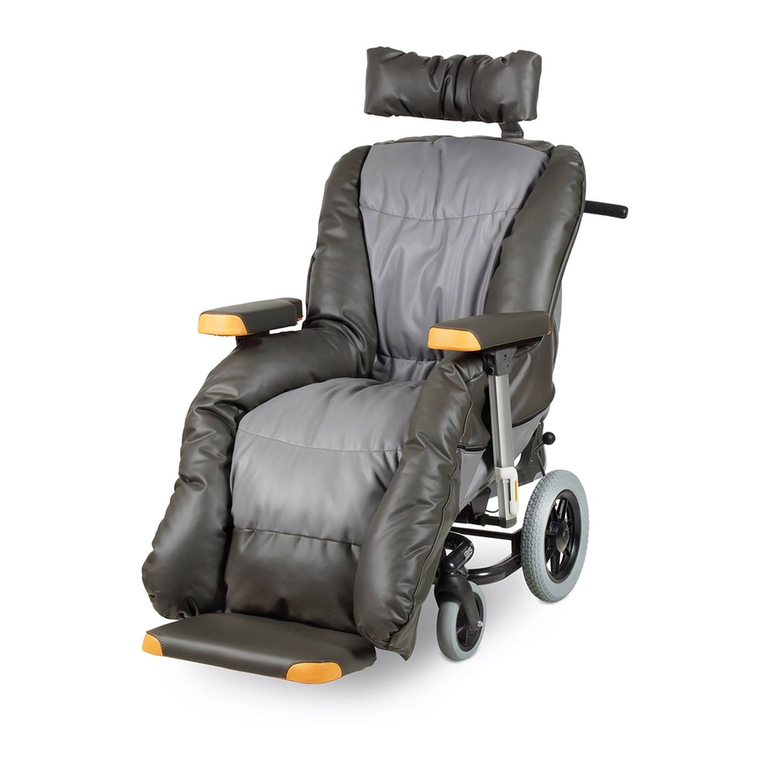
Breezy
Breezy Nuage PLS User manual

Breezy
Breezy 3406015 User manual
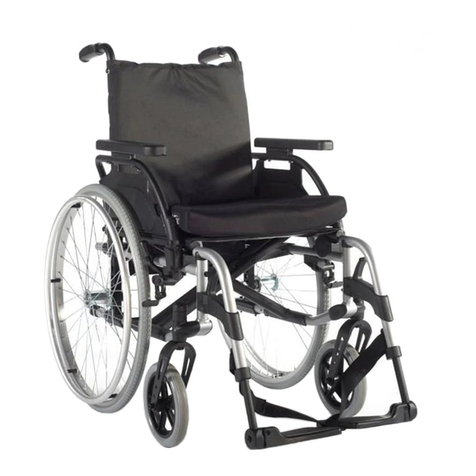
Breezy
Breezy BasiX2 Manual
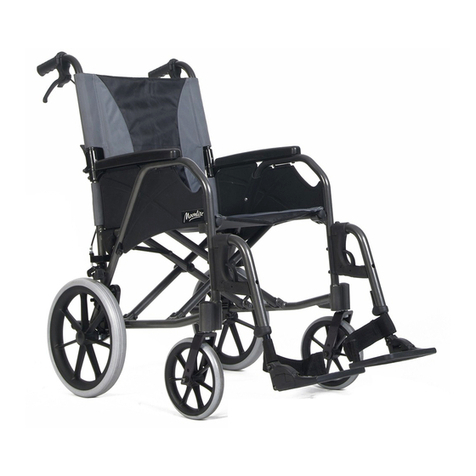
Breezy
Breezy Moonlite Manual

Breezy
Breezy Emineo User manual

Breezy
Breezy Ultra 4 Installation and operation manual

Breezy
Breezy Ultra 4 User manual
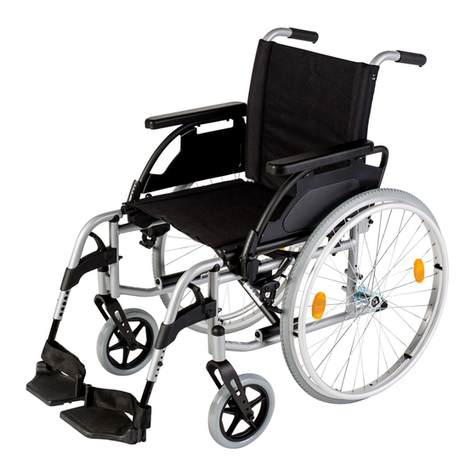
Breezy
Breezy UniX2 Manual

Breezy
Breezy Nuage PLS User manual

Breezy
Breezy IBIS User manual

Breezy
Breezy Nuage PLS User manual
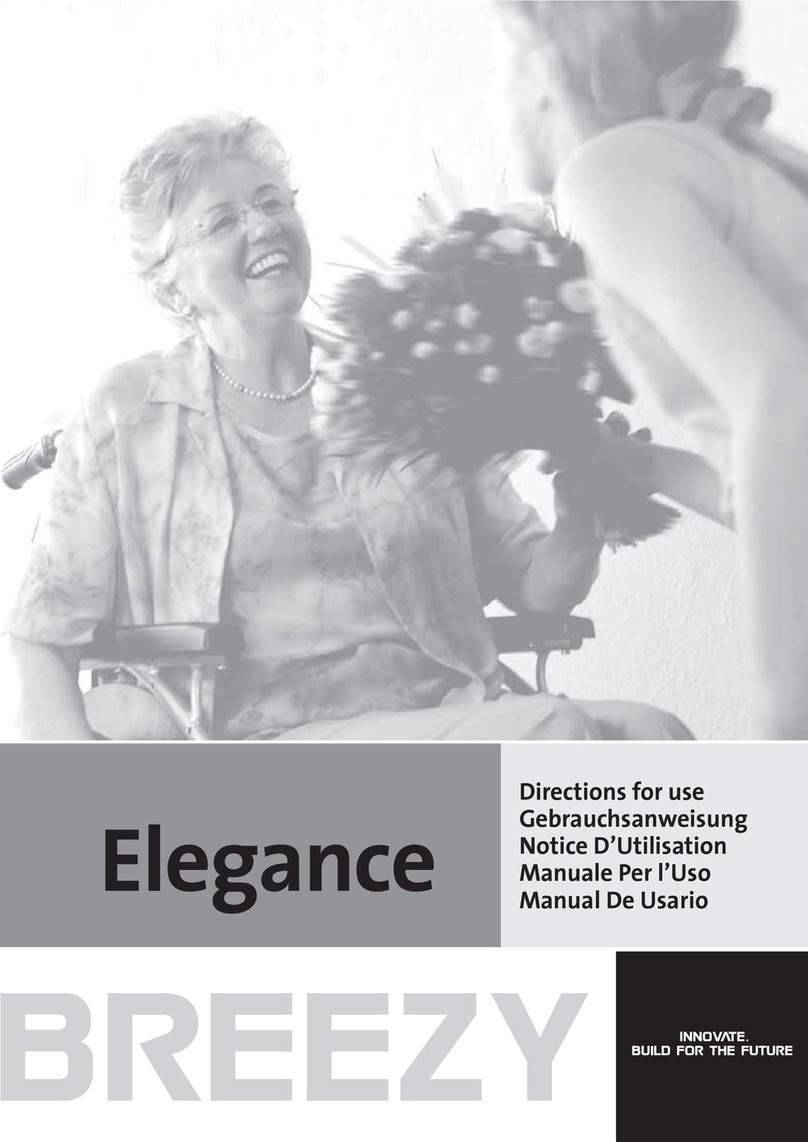
Breezy
Breezy Elegance Manual

Breezy
Breezy Exigo 30 User manual
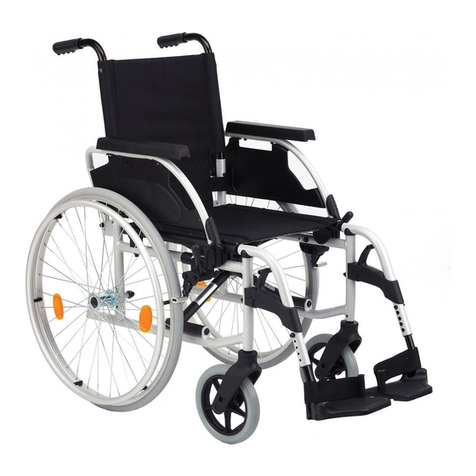
Breezy
Breezy UniX Manual

Breezy
Breezy Exigo 30 User manual
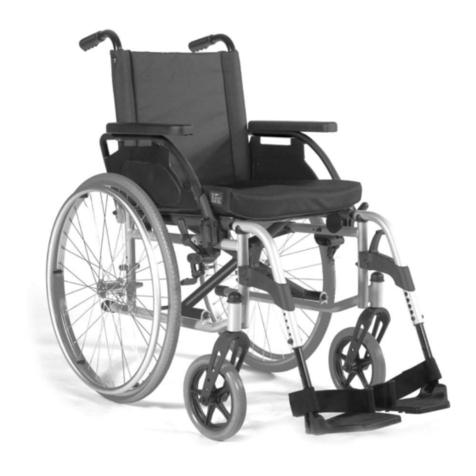
Breezy
Breezy UniX 2 Manual

Breezy
Breezy Breezy Premium User manual



